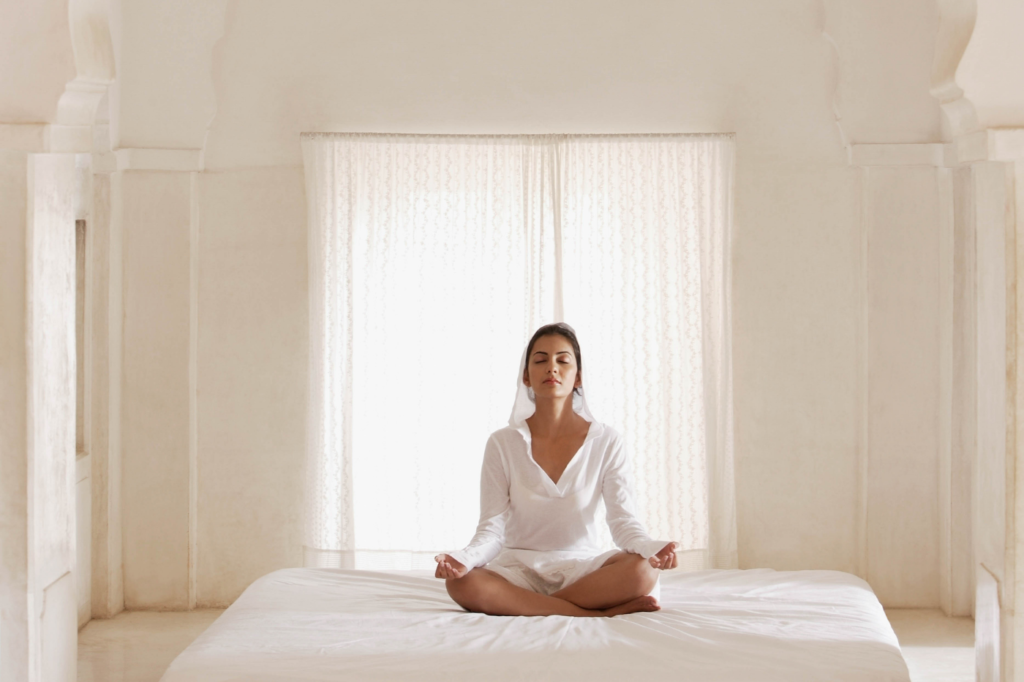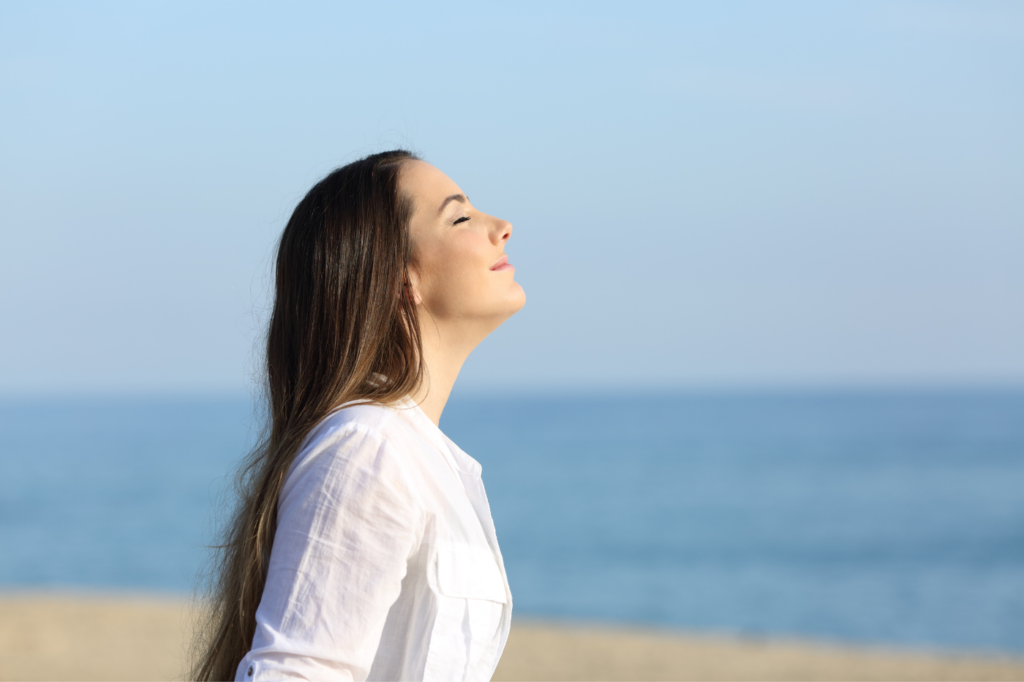 It seems like the world gets louder and busier every year. As Marie Kondo’s tidying up methods sweep the world, it leads to another question: How do we declutter our minds?
It seems like the world gets louder and busier every year. As Marie Kondo’s tidying up methods sweep the world, it leads to another question: How do we declutter our minds?
Could a clean, calm mind actually benefit the entire body, even our beauty and skincare?
From my background in psychology, I can tell you there’s no better way to achieve inner peace than mindfulness meditation. This practice has proven medical benefits, and adding it into your daily routine can change not only your mood, but even your aging process.
Here’s how to get started.
Beauty Benefits of Meditation
When we think of meditation, we often think of a serene yogi or a wise old saint. The term can have a zen-like or religious connotation, but there are clear beauty benefits to meditation sessions.
Meditation isn’t just for monks — I highly recommend it as a dermatologist as well. Studies have unearthed that meditation can improve your overall well-being, both inside and out. Here are just a few of the many evidence-based perks:
- Decreases flare-ups in many skin conditions. Meditation can relieve stress, which can worsen certain dermatological issues. Raised stress levels are linked to eczema and psoriasis flare-ups, and raised stress levels can even trigger acne breakouts.
- Reverse hair loss. Telogen effluvium is a stress-related hair loss, and it can happen to both men and women. It is totally reversible, but stress levels will need to be regulated to re-grow that hair. That means a lifestyle change, like meditation, can be an excellent step in your recovery from telogen effluvium.
- Regulate hormone levels. Meditation has been shown to regulate levels of cortisol and adrenaline, stress hormones that can damage the skin and create premature aging when they are out of balance.
- Improve beauty sleep. Sleep deprivation has been shown to speed up the development of fine lines, age spots, and other unwanted signs of aging. Meditation not only helps prepare the body for sleep, but can help you drop off faster.
- Boost happiness. Meditation is good for inner beauty, too. Studies show a positive relationship between meditation and happiness levels. Does meditation make you glow? Yes, meditation can make you glow with happiness!
Does meditation help clear skin? Yes, meditation can help to clear skin by reducing stress and inflammation. It’s worth adding to your beauty routine.
Not only can it help to clear skin, but the University of Sheffield found that mindfulness meditation can actually improve the quality of life for dermatology patients. As you can see, there are many reasons to give meditation a try for both outer and inner beauty.
Types of Meditation for Beauty
There are many types of meditation for beauty, and there’s sure to be one suited to you. You may want to work your way through these four meditation techniques to find what works best for your wellness needs, or even explore other options.
Remember, a meditation practice should be enjoyable and leave you in a relaxed state. Choose a meditation practice that feels right for you. What are the types of meditation? There are many types of meditation, but four of the most popular are:
- Sitting meditation: Try sitting in a chair with your feet firmly planted on the floor, or cross-legged on the ground (if this is comfortable for you). Try to clear your mind of distractions, allowing yourself to simply focus on the sensations arising in your body.
- Visualization: This technique involves the meditator picturing something soothing. Mountains, the ocean, a beautiful forest, and other natural settings are preferred to begin. You may imagine yourself as filling up with light or even kindness. Who knows? By the end of your practice, you may be visualizing yourself with healthy skin!
- Mantra practices: These meditations focus on a sound or phrase that is meaningful to you. It may range from the classic “om” or deep breaths to a thought like “I choose self-care and self-compassion.” Whatever your choice, a mantra helps bring clarity and focus, choosing what thoughts to focus on. Try a mantra from one of my favorite books!
- Walking meditation: This practice invites us to walk at a slower pace, becoming aware of the moments we take for granted: our surroundings, breath, and sensations in our body. It can be a particularly good option for those who don’t enjoy stillness.
6 Daily Meditation Tips
Meditation is clearly evidence-based and can be practiced in a variety of ways. However, it can be difficult to know where to start, or even to find ways to bring interest to your practice.
Try these 6 daily meditation tips to improve your practice, wherever you are in your mindfulness journey.
1. An App A Day
Having a beginner’s guide to help you begin your meditation journey can be very helpful. There are many apps that can kickstart your meditation for beauty, or simply keeping track of your progress as you try meditation for beauty.
Here are my recommendations for the best meditation apps:
- Headspace. The Headspace app is a great place to start if you’ve never practiced meditation before. It provides clear but minimal instructions to start you with meditation for beauty. The app includes both mini-meditations and full-length ones, as well as sleep help to prevent premature aging.
- Calm. This app has a variety of guided sessions that you can choose by topic, from anxiety to waking up. There are also video sessions that teach mindful movement; a great option if you want to try walking meditation.
- Aura. This app gives an option to choose your session by mood and to write a short reflection at the end of your session. It also has calming sounds to play if you’d prefer to guide your own meditation.
2. Box Breathing
Box breathing is a quick meditative technique you can use almost anytime, no special instructions needed. The premise of this practice is to take even breaths. Use this at your desk, at a stoplight, or in the tub after a long day.
Try this:
- Breathe in while slowly counting to 4, really filling your belly and lungs.
- Hold that breath for 4 counts.
- Breathe out slowly and evenly for 4 counts.
- Hold with no breath for 4 counts.
- Repeat 4 times.
3. Try A Track
Here are some of my favorite meditations, gathered all in one place for you. I find that listening to different instructors or focuses gives me a fresh boost of ideas for when I’m doing my own practice.
4. Focus In
A brief and simple meditative practice is to soften your gaze, focusing in on one object as you slow your breathing.
What do you notice about the object? Perhaps something new? What do you notice is shifting in your body as you narrow your focus and step away from distractions?
5. Create A Habit
A regular mindfulness practice is essential to building the skill and benefits long-term. Perhaps you can choose a certain time and place to be sure you meditate daily, if possible.
Where and when would mindfulness be the most pleasant for you?
6. Practice Self-Compassion
Maybe most importantly, it’s key to remember that not every session of meditation for beauty will go according to plan. Give yourself grace on the days where the distractions seem endless or you don’t feel as refreshed as usual.
Consistent practice is still valuable, and you’re only human!

Calm Your Mind… For Your Skin
With clear scientific benefits to meditation for beauty and so many types and tips to choose from, it’s hard to find a reason not to try mindfulness meditation. Your skin and your stress levels will thank you.
Can meditation make you beautiful? Meditation can do more than make you beautiful — it can help you realize how beautiful you already are. From the inside out, meditation for beauty is worth every moment.
Sources
- Langan, S. M., & Williams, H. C. (2006). What causes worsening of eczema? A systematic review. British Journal of Dermatology, 155(3), 504-514. Abstract: https://pubmed.ncbi.nlm.nih.gov/16911274/
- Farber, E. M., & Nall, L. (1993). Psoriasis: a stress-related disease. Cutis, 51(5), 322-326. Abstract: https://pubmed.ncbi.nlm.nih.gov/8513683/
- Zouboulis, C. C., & Böhm, M. (2004). Neuroendocrine regulation of sebocytes–a pathogenetic link between stress and acne. Experimental dermatology, 13, 31-35. Abstract: https://pubmed.ncbi.nlm.nih.gov/15507110/
- Shenefelt, P. D. (2010). Psychological interventions in the management of common skin conditions. Psychology research and behavior management, 3, 51. Full text: https://www.ncbi.nlm.nih.gov/pmc/articles/PMC3218765/
- Vandana, B., Vaidyanathan, K., Saraswathy, L. A., Sundaram, K. R., & Kumar, H. (2011). Impact of integrated amrita meditation technique on adrenaline and cortisol levels in healthy volunteers. Evidence-Based Complementary and Alternative Medicine, 2011. Full text: https://www.ncbi.nlm.nih.gov/pmc/articles/PMC3034982/
- Chen, Y., & Lyga, J. (2014). Brain-skin connection: stress, inflammation and skin aging. Inflammation & Allergy-Drug Targets (Formerly Current Drug Targets-Inflammation & Allergy), 13(3), 177-190. Full text: https://www.ncbi.nlm.nih.gov/pmc/articles/PMC4082169/
- Campos, D., Cebolla, A., Quero, S., Bretón-López, J., Botella, C., Soler, J., … & Baños, R. M. (2016). Meditation and happiness: Mindfulness and self-compassion may mediate the meditation–happiness relationship. Personality and individual differences, 93, 80-85. Abstract: https://psycnet.apa.org/record/2016-14379-009
- Montgomery, K., Norman, P., Messenger, A. G., & Thompson, A. R. (2016). The importance of mindfulness in psychosocial distress and quality of life in dermatology patients. British Journal of Dermatology, 175(5), 930-936. Full text: https://www.ncbi.nlm.nih.gov/pmc/articles/PMC5091630/


